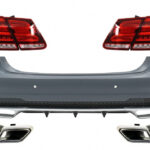Is it Safe to Drive with the ABS Light on?
An anti-lock braking system (ABS) is one of the many driver-assist technologies that help you to be safer while driving on the road. In most countries, newer cars are mandated by law to be equipped with ABS.
When the system develops a fault, you will see the amber ABS warning light on the dashboard turns on. What might be the possible reasons, and is it safe to drive? Read the article to find out.
Is it Safe to Drive with the ABS Light on?
As long as it does not affect the stopping power of the vehicle, it should be safe to drive. However, it is absolutely not recommended to do so, and you should drive it only if there is an emergency or if you want to take it to a mechanic to sort it out, which you should do as soon as possible.
The ABS is responsible for preventing the wheels from locking up under hard braking. When the integrated sensors detect slippage in the tires, it pulsates the brake calipers. As a result, the brake is released for a very short time at regular intervals at the limit of traction. But it does not have any impact on the amount of braking force or the distance it takes to stop the car.
It helps the tires to retain traction and prevents the car from going into a skid. It is particularly helpful during adverse conditions such as rain or snow, which essentially lowers the friction between the road and the tires, during which the tires are much more likely to lose traction.
If the ABS light comes on, it will not work as intended, and you will have a significantly higher risk of skidding. For a driver who is used to the ABS doing its job, it might require some additional effort to limit themselves from going too hard on the brake pedal.
If the car goes into a skid, the driver will lose control over the car, and it has a very high chance of sliding off the road or even into oncoming traffic, which is obviously a dangerous situation to be in.
If the braking system develops a fault, the red brake warning light will be illuminated. And if that is the case, it is not at all advisable to drive around in that car as it might be a serious problem, and it might not have the required braking power.
Even though it has been around since the 1920s, the ABS was made a standard feature for all cars irrespective of their price only during the late 2000s and the early 2010s. Before which it was a feature reserved for the more premium cars. As a result, older cars that are not equipped with ABS are quite common on the road. And they are not particularly unsafe cars either.
Also read: 10 Best Daily Driver Sports Cars Under $20k
What Can Be Wrong with Your Car if ABS Light is on?
Every time you start the engine, the ABS light may flash for a few seconds. This is completely normal, and it is checking itself to make sure that everything is in working condition. If the light persists, or if it turns on while driving, you might have a problem. The most common problems are:
1. Bad ABS Module
The ABS module is essentially the brain of the whole system. It compiles and processes the data from various sensors to detect any slippage in the tires. It decides when the ABS should kick in and assist the driver.
It is easily replaceable, and it is fairly cheap to buy a replacement. Make sure to get one that is compatible with your car. It might require to be programmed to your specific car, which requires specialized software available with authorized auto shops.
2. Faulty Speed/ABS Sensors
The speed sensors are present at each corner. They are responsible for measuring the speed of each wheel and providing it to the ECU and ABS module. The module determines whether a wheel is slipping based on whether it has a different speed compared to the others.
The sensor can develop faults due to debris from the road or the heat generated by the engine. If the sensor malfunctions, it can stop providing these values or might provide the system with the wrong values. In either case, your ABS will cease to work, and you will have to replace the sensors to rectify the issue.
Trending Video: How to Easily Bring Back to Life any Old Car Battery and Save Tons of Money (click to watch)
3. Bad Hydraulic Pump/Unresponsive Valve
The hydraulic pump regulates the flow of brake fluid under normal braking. The ABS uses the hydraulic pump to lower the brake pressure on individual wheels to prevent them from locking up under hard braking.
Over time, the pump can wear out from the constant load and impurities in the brake fluid. If it wears out, it will not be able to precisely control the flow of fluid. And if a valve malfunctions, the ABS will not work at all.
4. Bad ABS Tone Ring
The ABS tone ring helps the module to identify the speed of each wheel. It can either be installed around the driveshaft or in the wheel bearings. It can break over time due to corrosion or stress. You will have to replace it to make sure that the ABS is working.
5. Low Brake Fluid
The ABS controls the brake pressure on each wheel by regulating the flow of brake fluid using the hydraulic pump. If there is not enough fluid in the reservoir due to leaky brake lines or seals, or if there is air in the brake lines, the ABS will not be able to do its job properly.
If there are any leaks in the system replace the lines and seals. If there is air in the brake lines, bleed them properly to let the air bubbles out.
Also read: Is it Safe to Drive with Low Brake Fluid? (Solved)
6. Blown Fuse
Cars have fuses for almost all electrical components. It protects the components from momentary surges in power that could be caused by several reasons. It is very easy to check and replace fuses, so it should be your first step if the ABS warning light turns on.
7. Broken Wires
The wires for the ABS sensors are placed near the wheels, where they are exposed to mud and debris from the wheels. They also move with the suspension and rub against hard surfaces, which will degrade their outer insulation.
It can cause short circuits and improper communication between the systems, leading to failure of the ABS. Wires are fairly easy to acquire, but installing them can be a tricky job.
How Can Your Car Behave When You’re Driving with ABS Light on?
You might not be able to notice any immediate effect on the ride if it is caused by a blown fuse or malfunctioning module. But on the other hand, if it is caused by faulty sensors or a bad hydraulic pump, the effect will be much more apparent.
If the hydraulic pump is broken, or if there is not enough brake fluid in the system, you will feel that the brake pedal is unresponsive. This will usually be accompanied by the red brake warning light along with the amber ABS warning light. In older cars, it might just be the check engine light.
Eventually, you will need to press the brake pedal harder and harder to get the same amount of brake power. And you might feel the pedal trembling or pulsating, which is the ABS trying to prevent the wheels from locking up. Faulty sensors can cause the car to display incorrect speeds as well.
Also, remember that once the ABS is ineffective, you can easily lock up the wheels under hard braking. If you are used to driving around with ABS, you might unknowingly apply a lot of pressure on the pedals, which will cause it to skid. You should be wary of this especially during rain or snow.
Other systems such as the Traction Control and Stability Control which also make use of the same sensors as the ABS may also stop working. This is why you should exercise extra care and be delicate with the pedals to retain traction.
Also read: Are Car Stickers Tacky? What Do Drivers Say?
How Long Can You Drive with ABS Light on?
There is no recommended safe distance that you can drive with the ABS light on. You should try to rectify the problem as soon as possible. If you are driving around with the ABS lights on, you are essentially driving a defective car, and that can be dangerous to other vehicles and pedestrians on the road.
If the brake warning light is on along with the ABS light, it is not at all advisable to drive the car. The car may not be able to use its maximum stopping power, and it can be very dangerous especially at higher speeds.
How to Drive Safely with ABS Light on?
If you have no other choice, but to drive a car with the ABS warning light on, you should follow some basic safety precautions. You should keep the car well below the speed limit. Try to be gentle with all the pedals. Accelerate and brake smoothly without any abrupt inputs. Leave a lot of space in between your car and the vehicle in front of you.






